Long Posts
- The Slate comes in one color – gray – because they intend for you to customize it with a vinyl wrap. Wraps are apparently cheaper than paint and with a wrap, you can get any design or color you can imagine. (I built the green version above using their online configuration app.)
- Hand crank windows.
- No screen. No speakers. But you can add both if you want them. I’m fine using my phone as the entertainment system and adding speakers.
- It starts as a pickup, but it can be converted into an SUV. Or a Fastback. Or a Jeep-style open air vehicle.
- “Slate University” teaches you how to take care of your own vehicle and customize it.
-
That’s if the current administration doesn’t destroy the EV market. ↩︎
-
Except for the color font. That’s a Patron exclusive. ↩︎
- Anxious. A car accident before Christmas. Wildfires in California. Insane political news. Sick kiddos. The general state of the world. It’s just one thing after another.
- Optimistic. While the state of the world is depressing, I’m excited about the direction at work. And I’m moving toward finishing my Ph.D.
- Still stalled. Had hoped to hit reset after the new year, but alas, things are just too chaotic. I was looking to start walking more this week, but the weather looks terrible. So maybe I’m heading to the gym until the weather improves? Don’t know, but I need to kick my fitness routine into gear.
- Typeface design. Spent a little time working on my new typeface design. Happy with the little prototype that I built.
- My blog. Thinking about some things I might want to change here. I’m more sure than ever that my Micro.Blog hosted site is the best possible option.
- Skeleton Crew. So good. I enjoyed the show from start to finish. And the finale briefly shows my favorite ships of all time. I won’t spoil it for you.
- South Carolina Women’s Basketball. Go Gamecocks. They are ranked #2 because of a loss to UCLA, but they look like they will fight for another national championship. They are so much fun to watch.
- NFL Playoffs. I didn’t watch a lot of the regular season, but I’m tuned into the playoffs. I’m not pulling for anyone in particular so it’s just fun to enjoy the games without a rooting interest.
- Drained. So many things to do at the end of the year. I was productive, but have not rested enough over the last couple weeks. I have two more days of vacation before I head back to work in 2025.
- Frustrated. We had a car accident before Christmas. The other driver ran a red light, although she swore she had a green light. Her passenger was incredibly aggravated and belligerent. Thankful for the helpful police officers, insurance agents and others that have helped us. But it’s just a complicated time to deal with a rental car and repairs.
- Optimistic. There are things I’m dreading about 2025, but personally, I’m optimistic about so many things. Finding that balance is challenging, but I’m going to keep pushing forward.
- Still stalled. I had some good progress late in the year, but I’ve been in neutral for the last couple months. Need to kick it into gear starting tomorrow.
- Typeface design. I’ve got some sketches for an experimental typeface. It’s not something that’s going to sell so it’s been on the back burner, but I feel like I really want to spend some time on it.
- InShow. Do I need another project? Not really. Is InShow 23 coming in 2025? Maybe…
- Skeleton Crew. Still loving this show. Looking forward to an episode tonight and then two more in this season.
- What if…? I know a bunch of people thought this season was weak, but I enjoyed it. Storm as Thor is wonderful. And I always love Captain Carter.
-
Get healthy. Once again, this needs to be my top priority. I made some good progress late in 2024, but I need to carve more time out for walking and exercising. And I need to continue to make better food choices. I turn 50 this year, and I’d like to be healthier at 50 than I was at 40. To pull that off, I need to put a lot of work in between now and the beginning of August. I’ve got some more specific plans for getting more active.
-
Write. In Spring 2025, I have two Ph.D. classes. And then, from there, I’m writing until my dissertation is done. If I stay on the current pace, I have a year and a half until I finish my Ph.D. And that means that by the end of 2025, I’ll need to have made significant progress on my dissertation. I feel like I’ve been in grad school forever – I started working on my MA part time six years ago – so it feels strange and unbelievable to finally have the end in sight.
-
Explore creative endeavors. In 2024, I launched a bunch of new typefaces and built a new website for my fonts. I’m really proud of what I accomplished creatively this year. For 2025, I want to finalize an experimental typeface design that I’ve worked on for years, but never really worked on seriously because it isn’t something I think will sell. However, I enjoy playing around with more unique, experimental concepts and plan to focus on that design this year. I also may resurrect InShow, a Columbia-based design show, but we’ll see if I can find the bandwidth and recruit a team.
-
Get organized and stay organized. Continue to refine and evolve my methods and tools for staying organized. With so much going on, task management is vital. I especially want to work on keeping my finances more organized this year.
- Excited. I’m excited for the Christmas season. Yes, most people started planning for Christmas early, but we have three family birthdays between Thanksgiving and Christmas. Hard to focus on Christmas when we are still celebrating birthdays!
- Proud. Of my kiddos. All three of them are growing up to be amazing people. I love them so much, but I’m also incredibly proud of who they are. I’m also very proud of my wife who is excelling in her Ph.D. classwork.
- Stalled. I ate two donuts for breakfast this morning… I’m going to have to hit reset after Christmas.
- Typeface consulting. Waiting on feedback a draft I provided. Refining some of the smaller things.
- InShow. Do I need another project? Not really. Is InShow 23 coming in 2025? Maybe…
- A history of media branding. In 1997, I wrote an honors thesis about media branding. I’m thinking about pulling the ultimate academic stunt and resurrecting it. I’d have to completely rewrite it – I’m sure it’s terrible – but I think I want to write a history of media branding.
- Skeleton Crew. I love it. The mash up of 80s Spielberg nostalgia and Star Wars. Incredibly well done, and not just fan service.
- Lower Decks. Star Trek’s animated comedy is coming to a close and it’s just brilliant. I think next week is the finale and I’m looking forward to how they wrap things up.
- Gamecock Football. Heading to the Citrus Bowl to play Illinois. No way they were going to make the playoffs with three losses, but this is a wonderful consolation prize.
- McLaren wins the Constructors' Championship. A great finale for Lando Norris and McLaren to win the Constructors' Championship. This is my first season watching F1 and it was excited down to the last laps.
SbB Emote: A colorful faux emoji set built in Fontstruct
I built a set of adorable icons on Fontstruct.
Adobe's Project Indigo a home run in tough lighting
A quick comparison of two shots at a baseball game show the promise of Adobe’s computational camera app.
Embracing old tools in new ways + two new Fontstruct designs
Experimenting with new features in Fontstruct, Photoshop, and Glyphs has inspired the creation of two new font designs, SbB Vertica and SbB Roundabout.
Artificial intelligence with a side of seasoned fries
A brief “review” of Bo-Linda: Bojangles AI-based drive-thru ordering system
Beware hype without details
Remember the invention that was going to revolutionize transportation in the early 2000s? Apparently not…
My Three Fontstruct Color Competition Entries
Every so often, Fontstruct has a themed competition and the current competition focuses on the new color features. I’ve pulled together three color designs that try to use color in different ways — a pattern, a bright multicolor whimsical design and a 3D effect.
One of the fun things about the competitions is the amazing creativity that comes out of the community. Fonstructors can interpret the theme is very different ways and it’s always amazing to see the varied approaches driven by a simple prompt. I’ve entered a few times and even got an honorable mention once in the “Reverse” Competition for SbB Codebreaker. I will also note that I’ve been impressed with how Affinity Designer has handled the color fonts. Seems to work flawlessly.
SbB Lumberjack
My first idea for a colored font was to make a pattern. I played with a couple of different patterns, but settled relatively quickly on making a plaid. One challenge was related to the scale of the pattern in relation to the size of the letters. My original plaid pattern was much bigger, but didn’t work well with some letters. I tried a couple of different sizes, but ended up with this one. This pattern is often associated with lumberjacks, but I think my wife has pajamas with this plaid pattern.
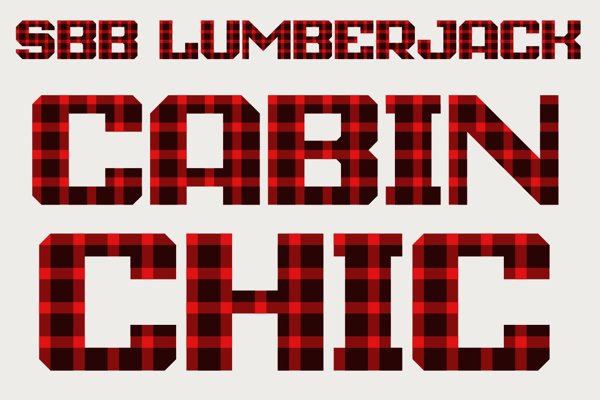
SbB Lightbright
I wanted to create a bright multicolored design. Really lean into the color theme. (And I always love to create Fontstruct designs that use a single brick.) I started with a square pixel, but eventually switched to a circle. The round dot reminded me of a Lite-Brite. I used Adobe Color to pick a color palette that would work on a black background. I wanted some whimsy, so I created a bouncing effect… Uppercase letters create a character in a higher position. Lowercase letters drop them down a block. So if you alternate case, the letters bounce up and down.
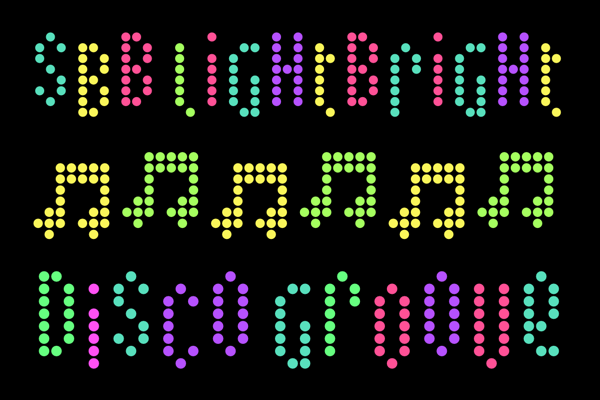
SbB Perspectives
Another random idea was to build a font that would work with 3D glasses. To be honest, I don’t have any 3D glasses laying around, but this feels like watching a 3D movie without the special glasses. So mission accomplished. I kept the design simple, because the type needs to be large to experience the effect.
 ---
---
Not sure if any of these will be selected as winners or honorable mentions, but I’m really happy with how they turned out. And I can’t wait to see what everyone else does.
Bob Wertz is a type designer, Ph.D. student and researcher living in Columbia, South Carolina. He’s been blogging since 2008.
Luxury experience
Reflecting on a favorite hotel in Charleston, SC that was just honored as one of the best in America.
Color fonts and signal flags
I’ve been thinking about color fonts lately. Experimenting with the color fonts features in Fontstruct and Glyphs. Trying to better understand how to create color fonts. And while I’m starting to understand how they are made, I’m left with one major question… why?
Why do we need color fonts?
If you don’t know, fonts are typically monochromatic. Black and white only. Color is applied in software like Adobe Illustrator or Microsoft Office. The ability to customize is limitless.
Often, the case for color fonts is made for the web. A complex typeface design with color features that can be encapsulated as a vector font and customized via CSS would be appealing. But color web fonts support is inconsistent across browsers. I also think web-based design apps like Canva and Adobe Express that cater to more novice designers might have a use for some pre-colored fonts.
I did think of one application — nautical flags. I built a font on Fontstruct in 2009 with black and white flags, so with the new color font tools, I colorized the signal flags and updated the design. I called it SbB Foxtrot Sierra Charlie1 and I’m really happy with how it turned out.2 Fontstruct now allows you to download a COLR v1 color webfont and it’s free to download if you are a Fontstruct Patron.
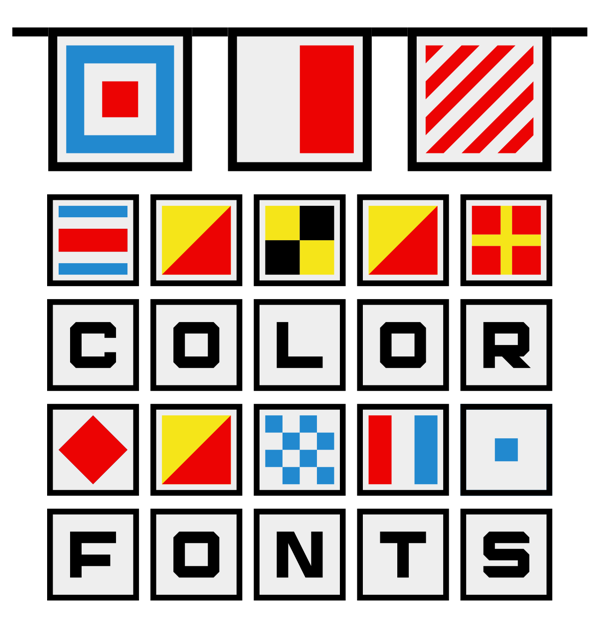
I’m going to keep playing around with it, but I think color fonts will be a custom, niche tool with limited applications.
Bob Wertz is a type designer, Ph.D. student and researcher living in Columbia, South Carolina. He’s been blogging since 2008.
Clean Slate
Slate Auto announced their new electric pickup truck this week, and I’m intrigued. If you haven’t heard about it, the Slate is a barebones electric truck — intended to be customized — all for under $20,000 with current Federal EV incentives.1
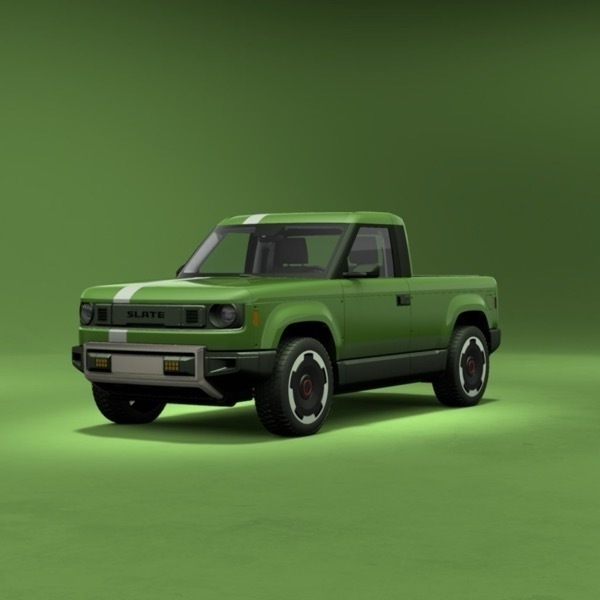
Some of these ideas have been tried before. Jeeps have always promoted modularity and customization. The Slate uses plastic body panels like Saturn did. Toyota tried to target youth with Scion, which was intended to be heavily customizable. But Slate takes these concepts further. Much further:
I love the base pickup, but the fastback looks great too. 150-mile range is plenty for my commute. I’m sick of boring car colors, and as a designer, I’d love to customize the wrap. The base safety tech checks all the boxes. It’s a completely different direction than every other car manufacturer is taking, and I can’t wait to see how it all comes together.
Bob Wertz is a type designer, Ph.D. student and researcher living in Columbia, South Carolina. He’s been blogging since 2008.
Return to Fontstruct
About 16 years ago, I started playing around with Fontstruct, an online tool for crafting modular typefaces. I’ve released 48 designs on Fontstruct and some of those have served as prototypes for designs that I finish in Glyphs, my favorite type design app. I tend to work in Fontstruct intensively for a while, and then disappear for a year or more. But I love the tool and contribute as a “Patron.”
Lately, I’ve been on quite the streak.
SbB Papaya. I was watching F1 and McLaren uses some modular numerals on their cars. Based on those numbers, I built an entire design. I wasn’t sure if the look was going to extend through the whole character set, but the design actually works pretty well. And as a bonus, the Fontstruct team selected it as a top pick.

SbB Powercore. I’ve had some drawings in my sketchbook of a unicase design that I like a lot, but haven’t gotten around to building. I wanted to see how the letterforms would work together so I built a quick pixel-font prototype.

SbB Astrometric. I took the basic letterform structure of Powercore and tried different approach. I thought this would look vaguely sci-fi when I started to build it, but as I built out the character set, it had a somewhat older feel. Not sure why. I’m really happy with it and this is one of those fonts that I’ll likely rebuild and polish in Glyphs. I think the design would work well as a variable font design.

SbB Theorem. I built this a few years ago, and forgot about it. So I dusted it off and added a few additional characters that I skipped over earlier.
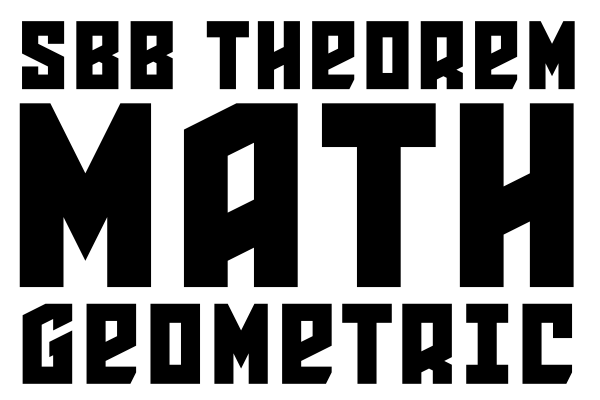
SbB Greenlight. All the cool kids are building color fonts on Fontstruct. It’s a feature that’s available for Patrons. I’d played with it once before to add some color to my Dingbots and Monsters design, but I hadn’t tried to build a color typeface. I built SbB Greenlight to experiment with the process of building a color design. I’m still not 100% sure why we need color fonts, but it’s a fun process and a pretty accessible tool for anyone that’s worked with design software like Illustrator or Photoshop that use layers to organize art.

You can download and use any of these1 if you set up a free Fontstruct account. I don’t know if I’ll keep up the pace, but I’m really enjoying building typefaces right now and I’m inspired by the other designers in the Fontstruct community.
Bob Wertz is a type designer, Ph.D. student and researcher living in Columbia, South Carolina. He’s been blogging since 2008.
Is it unusual that Columbia doesn’t have an Apple Store?
Columbia, South Carolina lacks an Apple Store, which is unusual given its size compared to other cities that have them.
Slightly melted
During lent, our church switches to a slightly melted cross recovered after the church burned in the 40s.
Five lectures
Five lectures that sparked my interested in grad school research: Lehrer, Gladwell, Larson, Tufte, Vinh.
Nine years ago, I wasn't in a mass shooting
Nine years ago today, a family outing to a mall turned chaotic when a false alarm about a shooting caused a stampede, leading to lasting fear and memories.
AI and Design: It’s what you make of it.
In a lecture at the University of South Carolina, NC State’s Helen Armstrong emphasized the importance of designers learning to use AI as a tool, collaborating with data scientists, and overcoming student anxieties about AI’s impact on the design profession.
Reflections from 1.19.2025
Posts in the “Then” category were originally shared on my “Now” page.
My first “Now” update of 2025. The start of the year has been chaotic. Cold weather and threat of snow, but only a couple of flurries. Then, last week, both kids had the flu. The semester started and I’m taking two classes. Work remains busy. Tomorrow is MLK Day and it’s a holiday for us. Hoping to use the day off to recharge and reset.
Feels
Health
Projects
Entertainment
Then: Reflections from 12.31.24
Posts in the “Then” category were originally shared on my “Now” page.
The last day of the year. It’s been a crazy couple of weeks leading up to Christmas and before New Years. A minor car accident complicated the already busy season. Everyone is fine, and it was the other driver’s fault, but now we are just waiting to find out if the damage is repairable. Thankful for good auto insurance.
Normally by now, I have a plan for the next year. And I guess I have some ideas, but I haven’t written it out yet. I probably need to go ahead and do that today or tomorrow, since, you know, 2025 starts tomorrow.
Feels
Health
Projects
Entertainment
2025: Incremental Progress
My themes for 2025 are essentially the same as they were last year. And the year before. I need to get healthy. I want to write and be creative. I need to stay organized.
It’s somewhat boring that my major themes have stayed the same for three years. I’ve made progress, but I still have a ways to go. I thought about changing them up, but these four goals still reflect what I need to work on so I’m sticking with them. Just some slight modifications…
And that’s the rough plan for 2025. Admittedly not that exciting. Stay the course. Keep improving slowly, but surely.
Bob Wertz is a type designer, Ph.D. student and researcher living in Columbia, South Carolina. He’s been blogging since 2008.
Then: Reflections from 12.15.24
Posts in the “Then” category were originally shared on my “Now” page.
First up, Happy birthday Norah! My oldest turns 20 today. Two decades is a long time and so much has happened… and yet, it feels like it has flown by.
I’ve seemed to settle in writing these updates every other week instead of weekly. Since they are mostly for me, I going to be okay with it. But if you happen to be reading along, just a heads up.